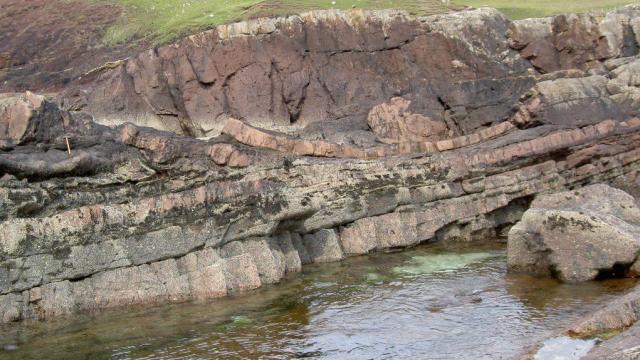Some 1.2 billion years ago, an asteroid measuring over 1 kilometre wide smashed into northwest Scotland. Trouble is, scientists aren’t sure exactly where the meteorite struck, as traces of the crater are long gone. With new research, however, scientists are starting to hone in on the impact zone.
A study led by Kenneth Amor from the Department of Earth Sciences at Oxford University suggests an asteroid measuring between 1 and 2 kilometres wide smashed into Scotland’s Minch Basin around 1.2 billion years ago. The estimated location of this ancient collision is just off the Highlands coast, around 15 to 20 kilometres west of Enard Bay.
The crater is no longer visible on the seafloor, having been buried by younger rocks over the course of hundreds of millions of years. Evidence of the ancient impact was detected in the reddish-coloured rocks of the Stac Fada deposit on the shores nearby. Analysis of these minerals allowed Amor and his colleagues to triangulate the location of the crater, which they describe in research published today in the Journal of the Geological Society.
“This marks another interesting chapter in the search for the crater from the enigmatic Stac Fada deposits in northwest Scotland,” Gordon Osinski, a geologist from Western University in London, Ontario, Canada who’s not affiliated with the new study, told Gizmodo in an email. “If the authors are correct, it would represent the first confirmed crater in the United Kingdom.”
Data presented in the new paper suggests the feature lies somewhere between the Scottish mainland and the Western Isles, but a geophysical survey will be required to provide definitive proof. Amor and his colleagues estimated the crater’s size at about 13 to 14 kilometres wide and 3 kilometres deep.
“It is gratifying to know now that Great Britain is blessed with its own impact crater, albeit a rather ancient one,” Jay Melosh, a professor of Earth, atmospheric and planetary sciences at Purdue University, said in an email to Gizmodo. “Unfortunately, the crater itself is not likely to become a tourist attraction like the USA’s Arizona Meteor Crater because it is completely buried under thick layers of younger rocks,” said Melosh, who also wasn’t involved with the new study.
Inklings of this ancient collision first emerged in 2008 when Amor, along with researchers from Aberdeen University, found evidence of what appeared to be the debris field of an ancient asteroid impact. The precise location of the crater, however, could not be determined.
In 2015, a gravitational analysis of the region suggested the crater was about 50 kilometres wide, and located to the east of the Stac Fada outcrop—a narrow belt that runs about 50 km north and south along the northwest coast of Scotland.
“However, this new study revises that estimate and, based on flow patterns in the deposit, instead suggests that the crater is only about 12 kilometres across and is located to the west of the outcrop!” wrote Melosh. “This uncertainty illustrates the difficulty of reconstructing the entire crater from a narrow strip of its ejected material. But it also illustrates the importance of careful analysis of flow directions from subtle clues in the deposit.”
Indeed, the crater may be invisible, but associated rocks on the shore provided important clues of the cataclysmic event. The approximate location of the crater was inferred through a couple of indirect methods.
“When the asteroid struck, tons of pulverized and molten rock, mixed with hot gases, were thrown out at high velocity in all directions from the rapidly forming crater,” explained Amor in an email to Gizmodo. “These debris flows [travelled] great distances at speeds of several hundred kilometers per hour. Eventually they came to halt, particularly if they encountered an obstacle such as a hill. At one outcrop we saw evidence where the debris flow came to a halt but the material behind it was still trying to move forward and was pushed up over the stalled material. This gave really great directional information for the crater origin.”
Amor and his colleagues also examined the alignment of magnetic particles within the rock.
“The mixture of hot gas and pulverized rock behaves similar to a high-density fluid,” said Amor. “The alignment of the mineral grains can give directional information of the current direction. This technique has been successfully applied to determine current directions in ancient river systems and volcanic ash deposits, but this is the first time it has been used for a meteorite impact.”
This particular impact happened when life was still very much in its primordial stage. No plants or animals were living on land, but some life existed in the oceans, such as microbes and the first forms of complex multicellular life. Also, Scotland was located closer to the equator back then, and it featured a semi-arid environment. Earth’s “landscape would have looked a bit like Mars when it had water at the surface,” noted a University of Oxford release about the research.
“Once we can pinpoint the crater location we could conduct a focused geophysical survey to determine the actual crater dimensions,” Amor said. “Impact craters on Earth are exceedingly rare being rapidly destroyed by erosion and plate tectonics or buried by sediment. The better we can understand how they formed the better we can understand observations on the rocky planets and moons of the solar system.”
Ideally, Amor would like to conduct a high-resolution, 3D seismic survey in the Minch Basin between mainland Scotland and the outer Western Isles. But “being offshore this would be very expensive,” he said.
As a final note, Melosh said the presence of this crater in the United Kingdom illustrates the fact that no portion of our planet is immune from meteorite impacts.
“Sooner or later—most of us hope later—a large impact will eventually visit the spot where we live,” he said.
